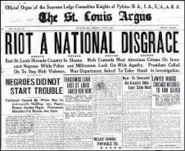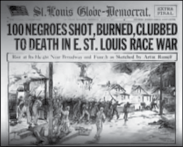By Rosalind Rhymes
The Scene staff
 Forest Park will host an event commemorating the 100th anniversary of the 1917 race riots in East St. Louis, but many students don’t even know about this bloody chapter in American history.
Forest Park will host an event commemorating the 100th anniversary of the 1917 race riots in East St. Louis, but many students don’t even know about this bloody chapter in American history.
Labor- and race-related violence left 39 blacks and nine whites dead, according to official records. Some reports put the death toll closer to 100. More than 300 homes and businesses were burned.
“I was never taught this in school,” said Danny Lawrence, 45, a business administration major.
Students and members of the community can learn more about the riots and honor their victims with “An Evening of Commemoration” on Jan. 23 in the lobby of the Mildred E. Bastian Center for the Performing Arts.
The event is one of several being planned by the East St. Louis 1917 Centennial Commission & Cultural Initiative. Members include communications adjunct Tiffany Lee.
“(It’s) an opportunity to reflect on past events that have served as the catalyst to shaping our thinking and actions regarding the significance of diversity and inclusion,” said Forest Park Provost Larry Johnson.
In the early 1900s, the city of East St. Louis was home to sprawling industries that burned coal from Southern Illinois mines. Aluminum Ore Co. had one of the biggest payrolls around.
 In 1917, many workers went off to fight in World War II, so companies needed labor, but they were facing a growing number of strikes. Tensions rose among whites after Aluminum Ore hired strikebreakers, many of them black.
In 1917, many workers went off to fight in World War II, so companies needed labor, but they were facing a growing number of strikes. Tensions rose among whites after Aluminum Ore hired strikebreakers, many of them black.
Angry white workers submitted formal complaints against black migrations at a city council meeting. Rumors circulated of an attempted robbery of a white man by an armed black man. Whites formed mobs, beating, stoning and lynching blacks. The worst violence occurred July 2.
“For an hour and a half last evening, I saw the massacre of helpless negroes at Broadway and Fourth Street in downtown East St. Louis, where a black skin was a death warrant,” wrote Carlos F. Hurd, a St. Louis Post-Dispatch reporter.

“The sheds in the rear of negroes’ houses on Fourth Street had been ignited to drive out the negro occupants of the houses, and the slayers were waiting for them to come out. It was stay in and be roasted or come out and be slaughtered.”
Lawrence expressed shock that so many people were killed in the riots, just because they needed work.
“This is America and everybody wants to be a part of the American dream,” he said. “It’s sad that people had to die trying make a better life for themselves and their families.”
General transfer student Stephanie Pham, 23, didn’t know about the riots, either.
“I’m from Clearwater, Fla., but I have never heard this story,” she said. “Why haven’t I heard about this? It’s important. People were just trying to live their lives and should not have been tortured to do so.”
On Jan. 23, the commemoration event will begin with hors d’oeuvres at 6 p.m. and continue with a formal program at 7 p.m.
Speakers will include Eugene B. Redmond, East St. Louis poet laureate and English professor emeritus at Southern Illinois University Edwardsville; and Karla Scott, associate professor of communications and director of the African American Studies Program at St. Louis University.
Truelight Baptist Church of East St. Louis will provide music. There also will be refreshments and an art exhibit by local high school and college students and professional artists, including the internationally renowned Edna Patterson-Petty.
“I am happy to share in this commemorative moment as it will showcase our solidarity and serve as a platform for enlightening all audiences,” Johnson said.
